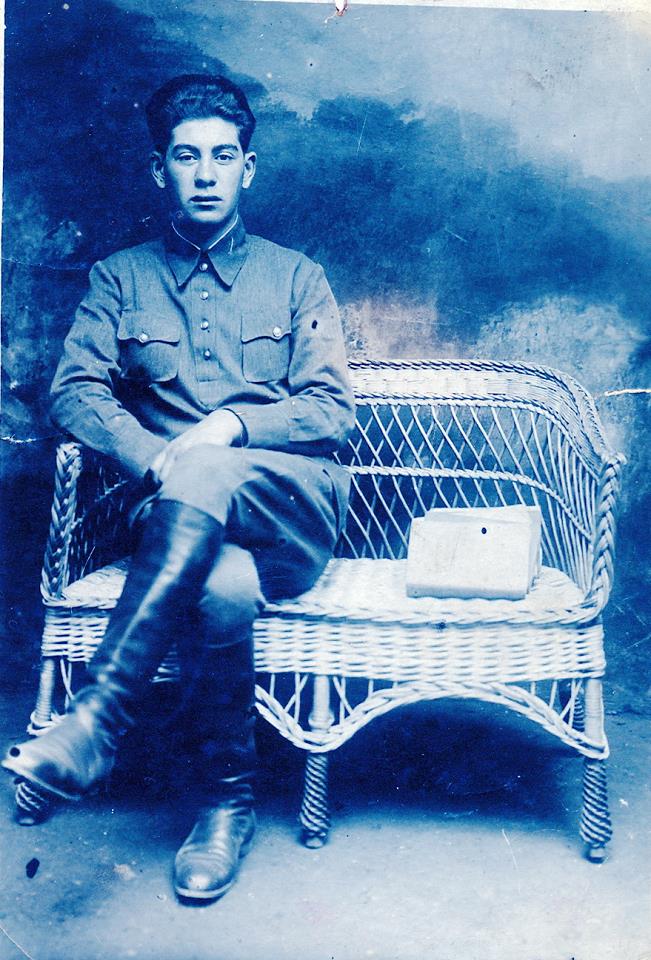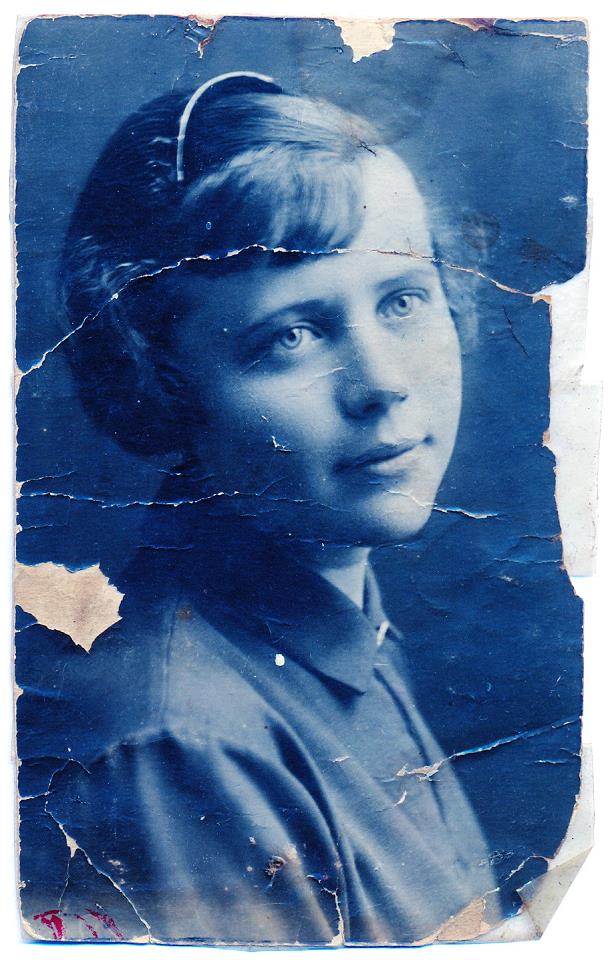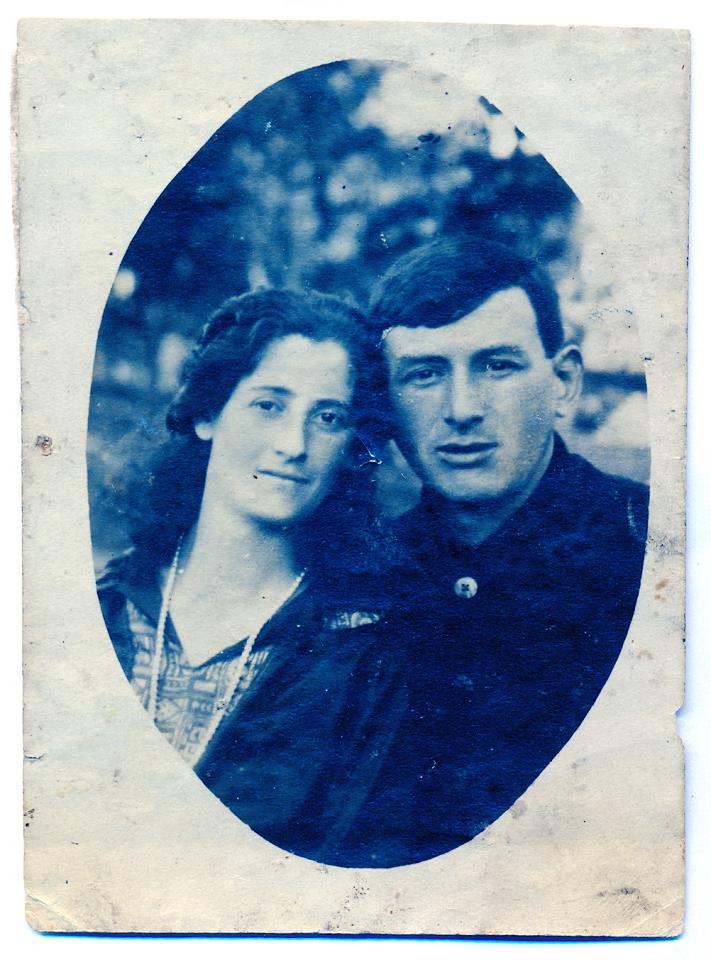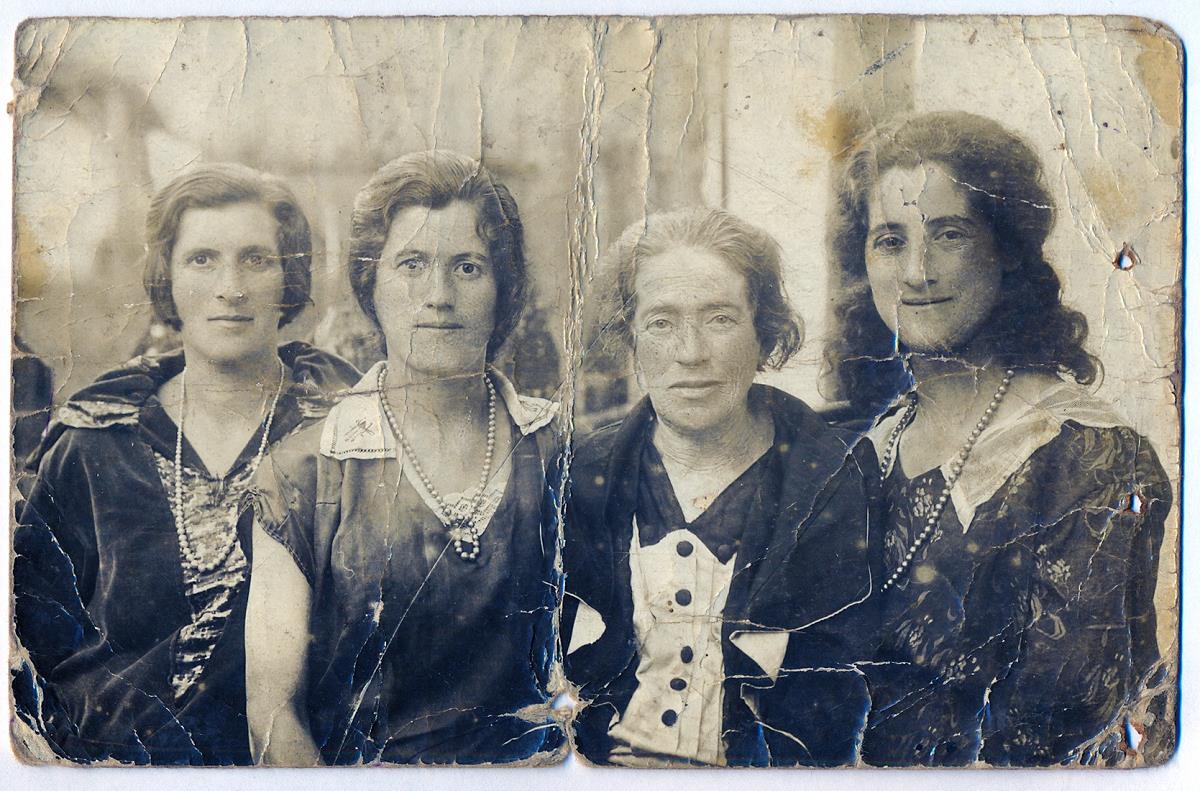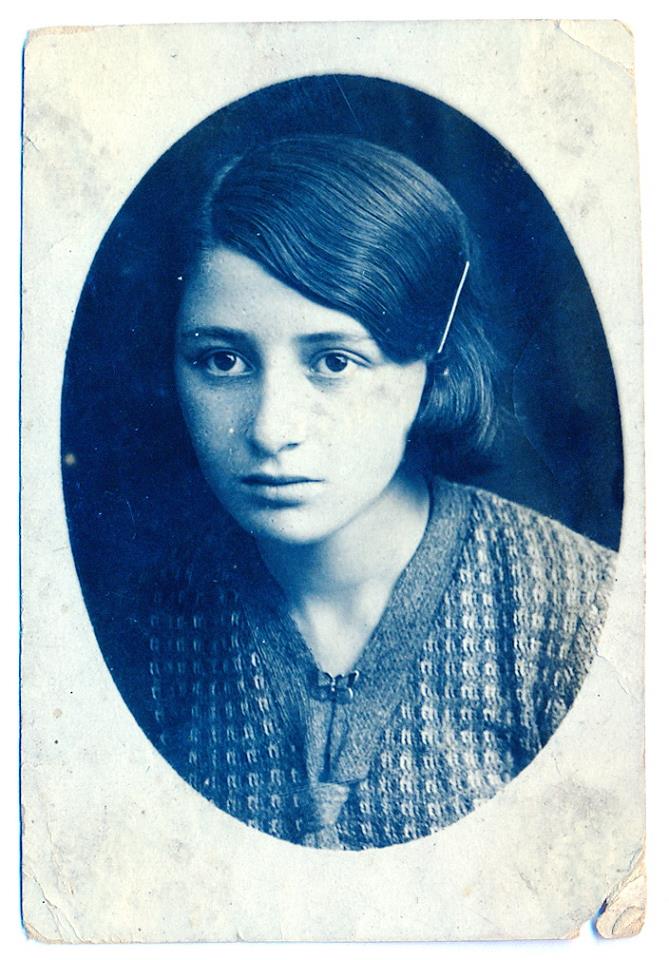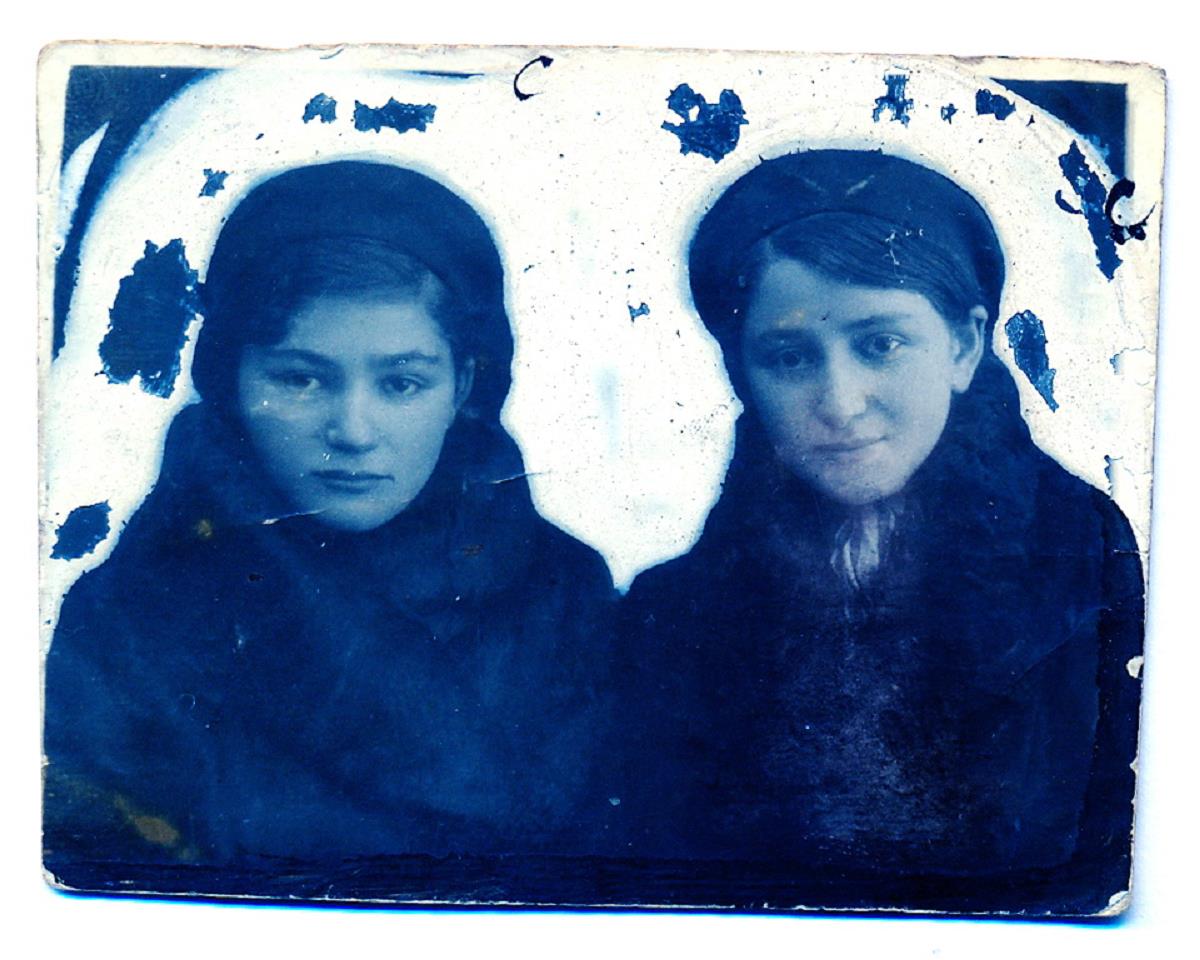| Dedication of Proskurov
Ghetto Memorial Plaque January 27, 2021 |
January 27 is Holocaust Memorial Day
PRESENTATION OF THE PLAQUE IN THE MEMORY
OF THE PROSKUROV GHETTO by Leonid Zapadenko - link
IN THE MEMORY OF THE PROSKUROV GHETTO by
Semyon Milman - link
Proskurov Ghetto Article in USHMM Encyclopedia - link
This group of pictures supplied by Leonid Zapadenko
Click images to enlarge

Proskurov Ghetto Memorial Plaque
|
Views of memorial dedication ceremony
 Semyon Milman speaking at ceremony |
 Placing Flowers |
 |
Proskurov Ghetto Maps
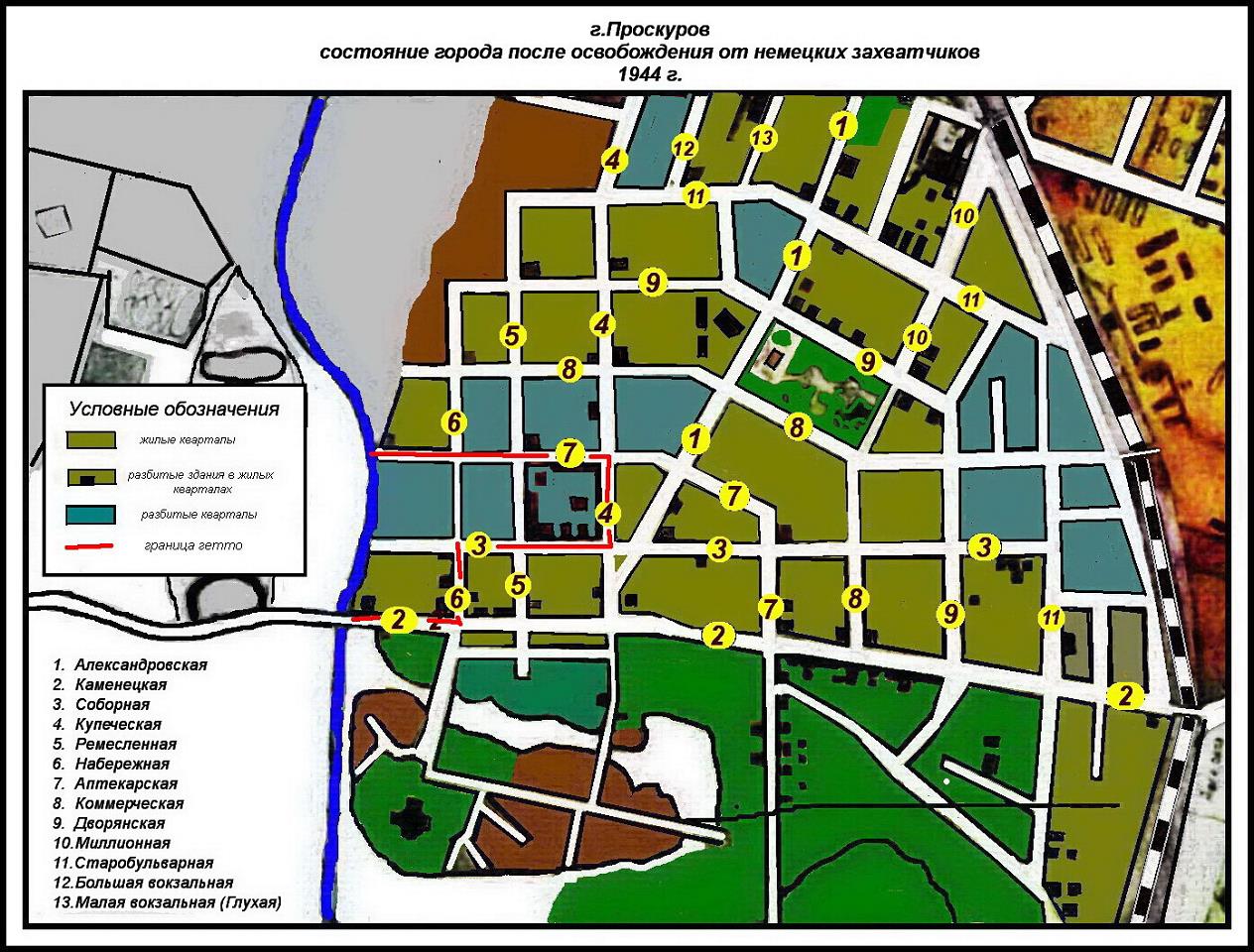 |
 |
|
PRESENTATION OF THE PLAQUE IN
THE MEMORY OF THE PROSKUROV GHETTO
by Leonid ZapadenkoThe Memorial plaque was opened by the deputy of the Khmelnytskiy mayor M. Krivak and the director of the Chesed Besht Foundation, Honored worker of the social sphere of Ukraine, I. Ratushny. The representative of the regional state administration, M. Krivak, the deputy chairman of the Khmelnytskiy regional council V. Sokolyuk, the volunteer of the Chesed Besht Foundation, S. Milman, the former prisoner of the ghetto, L. Podlesny, the author of the bas-relief, artist and sculptor Vladimir Karvasarny, and a representative of the younger generation, P. Getmanyuk, addressed the meeting. Rabbi of Khmelnytsky, Yosef Teitelbaum, read the Kaddish memorial prayer in the presence of the minyan. A letter of condolences from the Head of the State Service for Ethnopolitics and Freedom of Conscience of Ukraine, A.V. Bogdan, was also read out to the participants of the meeting. Memorable signs and monuments are what keeps us as a people. The establishment of the sculptural bas-relief is a tribute to a historical fact, a bow to the remnants of those whose names were erased from our history 80 years ago. We strive to preserve the memory of the events of the Second World War in order to prevent the great human drama of the Holocaust from fading into oblivion. Humanity must do everything to prevent such a thing ever, with any nation. Edited and translated by Eugenia Sheinman |
|
IN THE MEMORY OF THE PROSKUROV
GHETTO
by Semyon Milman
On January 27, 2021, in Khmelnytskiy, there happened a
presentation of the Мemorial Plaque in the memory of
16,000 tortured and murdered Jews, residents of
Proskurov and nearby villages. This event was coincided
with the International Holocaust Remembrance Day. Let me
briefly tell of the Proskurov ghetto tragic history.On July 8, 1941, German troops entered Proskurov. Оn September 14, the order of the Gebitskommissar was spread around the city on the forced, under threat of execution for disobedience, the resettlement of the Jewish population to the ghetto. The ghetto was located in the poorest part of the city, near the river of Southern Bug, which limited the ghetto territory from the north. The whole ghetto was fenced with barbed wire. In addition, at the river side, there were put watchtowers, with searchlights and machine guns. The ghetto was guarded by the Ukrainian policemen around the clock. Living conditions in this branch of hell were terrible, inhuman. The living space was overcrowded. In each small unheated room there lived several families - without medicines, water, food, in highly unsanitary conditions. Mortality in the ghetto due to hunger, cold, diseases, was awful. Each day one and a half thousand men were taken out of the ghetto under strict escort to hard work, to humiliation and death on the spot under the slightest pretext. For me, the stories about the unthinkable conditions of life in the ghetto, about its terrible end on November 30, 1942, are confirmed by my personal experience. My father, Lev Semyonovich Milman, and his large pre-war family (wife, four children, his and his wife's parents) were prisoners of the Proskurov ghetto. On this site there is my story about the tragedy of the entire family. Only my father could miraculously escape from the ghetto on the eve of its destruction in the hope to prepare the shelter for the whole family, but was late, alas. The rest of the family members were killed in the terrible "Action". Almost 76 years have passed since the end of the terrible war and more than 78 years since the destruction of the ghetto. We, the Jewish residents of the city, still have kept sad memories of our killed parents, brothers, their kids. Perhaps one of the dead or their descendants would have glorified our city and country in front of the whole world, developing a cure for a terrible disease, discovering a new source of energy or finding a formula for happiness. We dreamed of perpetuating the memory of the dead prisoners of the ghetto and tried hard pursuing this important goal of ours... But neither under Soviet rule, nor even 20-30 years ago it was possible to install a proper memory sign. After the collapse of the Soviet Union, there were attempts to establish such a sign. For example, in 1998, the Jewish community installed a granite plaque on one of the city buildings with an inscription announcing that there was a ghetto here in 1941-1942. The board is gone. It disappeared. The local Jews did not look for it since the initiators of the installation of the board were afraid to get accused of having violated certain state laws and regulations. And only in 2020 the documents were agreed, the commission passed and the permission to install the memorial plaque was received. The new memorial plaque in memory of the ghetto prisoners was made by order of the Khmelnytskiy city council and the Khmelnytskiy Jewish charitable foundation "Chesed-Besht". And now, finally, on January 27, 2021, the Мemorial plaque was installed! We are passing through very hard time now. We have difficult economic situation in our country, the terrible coronavirus pandemic and even a decrease in the number of Jews living in the city. If we have analyzed all these circumstances, then the event we have celebrated can be considered only as an accomplished miracle. The Divine Providence has united many people of different nationalities, political views, religions, professions and positions to fulfill the task of preserving the memory of the murdered Jews. The Jewish community of the city, and I personally, are grateful to the city administration, to the director of the Chesed-Besht charitable foundation, I.A. Ratushny, and to all those who helped, financed, organized ... And, of course, to the creators of the memorial plaque - Vladimir Karvasarny and Vladimir Petrovsky, artists from Khmelnitsky. Both of the artists have done a wonderful job! Our friendship with V. Karvasarny has lasted on for over 30 years. He helped us a lot in construction of the Chesed-Besht administrative building in Khmelnitskiy and helped also during the construction of a memorial complex dedicated to the executed prisoners of the Proskurov ghetto. Therefore, I suggested to Ratushny to entrust the creating and installation of the Memorial plaque to V. Karvasarny, an accomplished artist who worked in many genres. His young colleague, Vladimir Petrovsky, has also performed excellently the important job for us. The dead do not need a memorial plaque. We, the living, need it. The installation of the plaque at the place where the Proskurov ghetto was established by the enemies of humanity is a manifestation of deep respect for the blessed memory of many thousand innocent victims. We want the memory of this tragedy to never extinguish or go away. We want to instill a sense of tolerance in the younger generation, we want our descendants to experience feelings of grief and respect for the murdered. And, of course, we condemn the Nazi bloody regime in the occupied territories. It was not only the extermination of Jews. The residents of Ukrainian villages in Teofipol’ and Shepetovka districts were burnt alive, there were many residents who were killed and maimed during punitive actions and in Nazi prisons, young Ukrainian people were driven to Germany for hard labor as “Ostarbeiters”, or slaves. These also were hundreds of thousands of Red Army prisoners of war who died of starvation in death camps in our region alone. We pray to the Almighty God that this tragedy will never repeat with any nation. Merciful God, grant peace to all souls of the victims of the Catastrophe, may the souls of all killed be in the Garden of Eden - in Paradise. About the plaque. Themes and symbols. This plaque is a sculptural bas-relief measuring 1000 mm x 1500 mm, made from a composite material outside and filled with concrete in a metal frame inside. This bas-relief is made in the form of a torch with the faces of ghetto prisoners inside it. The torch is the emblem of sacrifice and of the blessed memory of the dead, also the torch is a light giving appliance and a symbol of life. However, millions of people were burned to death in the flames of the Holocaust, and the people depicted on the board were also destroyed at that time. Their lives (as well as their faces) were crossed out by two horizontal fragments of barbed wire. The wire symbolizes not only the captivity situation of the people who are depicted on the plaque. It shows the bestial Nazis hatred of the Jewish people, its culture and religion. The biblical faces depicted here are an image of the entire Jewish people. These people depicted in the plaque are not afraid of impending death. They are calm, wise, spiritualized, filled with faith in the Almighty, in his justice, in the inevitability of punishment for the organizers and perpetrators of the murder. As it said in the Prayer in memory of those killed in the Holocaust: "Remember the rivers of blood that poured like water, the blood of fathers and sons, mothers and babies, teachers and their disciples, avenge the oppressors of Thy people... Take revenge soon, in our days, before our eyes, by blood revenge for Thy sons and daughters, saints and pure". In the upper right corner of the bas-relief we see a menorah, the oldest symbol of Judaism, a symbol of the Jewish people, ancient and eternal, one of the most important Jewish religious attributes. However, on the plaque we see an overturned extinguished menorah. This is the reality of a world tragedy, it is a symbol of the disaster, calamity of the whole Jewish people, a reminder of unbelievable cruelty, of persistent pain. Symbol of a piercing scream - FOR WHAT? Under the image of the menorah, we see a text with roughly carved letters. Under the faces of the dead there are five letters: tet, nun, tsadi, bet, hey. This is an abbreviation of the Hebrew phrase, translated like this: "Let their souls be tied in the knot of life." It is taken from the text of the memorial prayer Yizkor. The Talmud says that with these words the angels greet the souls of the righteous ascending to heaven, who have completed their stay on earth. According to Jewish tradition, these letters are usually written on gravestones. The oldest of the Jews holds a Torah scroll, the most sacred object of Jewish religious worship. The six depicted persons of different ages are housed in a confined space bounded with the barbed wire. They are surrounded by calamities on all sides. These people, innocent, are driven into unbearable conditions of life, but nevertheless they continued to pray G-d, to believe and to hope, which fully corresponds to the words of the Psalm: “From the narrows I called to G-d, and answered me G-d" (Psalms, 118:5). Installation site It was difficult to choose a place for the installing the memorial plaque. The main condition for the choice of the place was like this: the plaque should be installed on the territory of the former ghetto and should be seen well from different directions. We wanted that as many people as possible could see the plaque. Also, it was necessary to get the owner's permission to install the plaque on the facade of his building. The needed place was found, and there was no alternative to this place. So, it was agreed with the city authorities by I. Ratushny. The house is located on the site of the historical compact residence of Jews, where they lived for over 200 years, on the street named after the fallen Jewish warrior, the Proskurov native, Vladimir Weiser, who had got the highest reward of the Hero of the Soviet Union. Opposite the house on which the Plaque was installed the building still stands in which, during the Nazi occupation, the Ukrainian police station was located, which administration managed guarding the ghetto and giving their current assignments to the numerous policemen. A punishment cell was accommodated here as well. In the “handle” of the bas-relief "torch", we see an inscription in two languages - Ukrainian and English. It provides the necessary information about the ghetto. The phrase "they wanted to live too" is included in both inscriptions; on behalf of the murdered it appeals to the feelings of each person, it asks to preserve the memory of the victims, not to let the tragedy be forgotten. The twentieth century is the beginning of the end of the long Jewish presence in Ukraine and, more broadly, in Eastern Europe. Perhaps in two or three generations, or even earlier, the Jews will no longer live here. They had to endure a lot of blows in the last century, starting with the First World War, which was followed by the revolutions of 1917, the Civil War with its bloody pogroms, and, finally, the full destruction of the Jewish ethnos in Ukraine which was carried out by Nazi Germany. There are still a handful of us (a tiny portion in comparison with the former huge community of our brethren here). But we will inevitably leave this place too - if not we, then our descendants, as we, Jews, had left many places of our settling throughout our almost 5000-year history. And our duty is to perpetuate the memory of those who will remain here, in the bloody soil, whose shadows will hover over the mass graves and over the places of their torments. This plaque is one more step we have taken in fulfilling our duty of memory. Edited and translated by Eugenia Sheinman |
|
Note from Eugenia
Sheinman
Semyon has sent me today pictures of several previous
version of this Memorial plaque. Origin of the pictures of the Proskurov ghetto's victims which are on the plaque Also he answers my question on the origin of the pictures of the Proskurov ghetto's victims which were on the plaque. He wrote that 18-year-old Ukrainian girl had fall in love with the Jewish young man before WWII. As soon as the war launched he was enlisted for the Soviet Army and his parents were taken to the ghetto. She visited them in the ghetto. It was she who saved those photos from annihilation. Her groom returned alive after the war came to the end and married with her. I've asked Semyon to continue the story of these pictures. After I get his respond we put this story as P.S. to my translation of his previous text. |
| Here is the story The rescued pictures and other Marder/Milman family pictures are presented at the end of this story (Link) |
|
Phоtos from the
Ghetto
On the International Day of Remembrance for the Victims
of the Holocaust, January 27, 2021, in the city of
Khmelnytsky, a Мemorial plaque was opened, dedicated to
the memory of the Proskurov ghetto prisoners, executed
by the Nazis in 1942. The artist and sculptor, V.
Karvasarny, found an unusual, a non-trivial way to show
the tragedy of our brethren’s death in the flames of the
Holocaust. The plaque is a bas-relief which has been
performed in the shape of a torch. In the flame of it
people are burning. We see their faces! And we assume
that these faces should have a portrait resemblance to
the faces of real prisoners of the ghetto! Yes, indeed,
it was originally intended to perform the plaque this
way! - confirmed the volunteer of the local Jewish
charitable organization "Hesed-Besht", Semyon Milman.
From the very beginning of the plaque creation, Semyon
oversaw / supervised/ its design and manufacturing, and,
as I learned, it was Semyon who provided V. Karvasarny
with copies of pre-war photographs of ghetto prisoners,
whose faces were supposed to be embodied in a
bas-relief. Naturally, I inquired about the origins of
these photographs of Holocaust survivors, intended for
such a soul-stirring new incarnation. I will tell now
the tragic and, at the same time, life-affirming story
of the rescue of these photos from the Proskurov ghetto,
- I will present what I learned from Semyon Milman.This story is about love and compassion, about kindness and decency, about the high qualities of the human soul. It began in the last pre-war years. In 1939, two young persons, Syoma Marder and Maroosya Mikhailovskaya, came to work to the elementary school at the orphanage in the village of Vodichki, after completing six-month courses at the Pedagogical School in the city of Kamenets-Podolskyi. An eighteen-year-old Ukrainian girl became a preschool teacher, a Jewish youth of the same age started working as a physical education teacher there. Before that, they did not know each other, as they lived in different villages. In this orphanage, they met, and it was a fateful meeting - they fell in love with each other. They had different appearance and characters. In the photograph of Maroosya of 1938, we see a fragile girl of angelic appearance. She was thin, fair-haired and blue-eyed young girl. And Syoma in those same years was a tall, athletic guy, swarthy, black-browed and black-eyed, with thick wavy black hair. And they had different characters. The explosive active Syoma was opposed by the kind calm Maroosya. In what village Maroosya lived, I do not know exactly. Presumably, it was a village of Vodichki, because it was the only place in Proskurov vicinity, where the concentration of the residents with surname “Mikhailovsky” lived in 1930s. She had the parents and a brother, who perished in the battles of WWII. I know more about Syoma's family. All his big family of the Marders – his parents, sisters and younger brother - lived before the war in the old shtetl of Mikolaev, located on the border of Podolia and Volhynia, 20 kilometers north-west from Proskurov. The shtetl was founded by voivode Mikolai Seniavsky in 1555 (!) and was called by his name. The Jewish community appeared in Mikolaev in the very old times, even before Bohdan Khmelnytsky uprising, and long before three partitions of Poland at the end of the XVIII century. In the time preceding the partitions of Poland, and after them, Mikolaev belonged to the Polish aristocratic family of Czartoryskis. It had become their property when Lady Senyavsky, the rich heiress of the landlords Senyavskys and the last owner of the shtetl of Mikolaev married one of the Czartoryskis. Prince Adam Czartoryski, owning huge wealth, was known by his liberal views. It was his custom to provide support to sages, including Jewish ones, so they could devote themselves entirely too learning and spreading knowledge. The Prince learned somewhere about the scholar Rabbi Mendel (1741-1819), the son of Rabbi Yehuda-Leib, of Satanоv, who had studied up not only the whole Talmud, but also all books on mathematics, biology, astronomy, etc., translated by that time into Hebrew and Yiddish, mastered several languages, and had spent two years in Berlin - in the circle of Moses Mendelssohn. The prince was so impressed with the erudition and wisdom of the rabbi that he invited him to Mikolaev and ordered to permanently support him and his family for the rest of his life. It is known that close acquaintance with Prince Czartoryski gave Rabbi Mendel the opportunity to help his brethren. Those were the people who once lived in the shtetl of Mikolaev. The number of Mikolaev's Jews in 1717 was already 250 people. Around the middle of the XIX century, there were 377 houses there, the population of the shtetl was 1,848 residents, and half of its inhabitants were poor Jews: artisans and small traders. There was a church, the catholic Cathedral in the name of St. Nicholas, built with the money of August Czartoryski, a town hall, a synagogue, 47 shops, 117 artisans, a brick factory, a cloth factory, a hulling mill and a postal horse station. 25 large bazaars, like fairs were carried out here in year. In 1923, there were 1203 Jews in Mikolaev. It was about half of the number recorded during the All-Russian Census of 1897, according to the results of which 2,189 Jews lived there that time, 70% of the total population of 3,661 people. It means that in 20+ years after that Census, the population of the shtetl has undergone a significant decline due to wars, revolutions, and pogroms. This is not surprising - the same picture might have been observed throughout all the Pale of Settlement. Among the Jews who remained in Mikolaev, there lived the Shuster couple, Abram and Ester. They had three daughters, Klara, Polina, and Dvoira, and a son, Iosif. All women of the Shusters were beautiful, and all members of their family were musical. Polina sang well and played in the Jewish theater - the shtetl had its own theater, Iosif played the violin. In 1920, Polina married Shlema (Shlomo) Nachmanovich Marder, and by the end of the 1920s they had four children: Syoma was born in 1921, Idochka in 1924, Nessi (Nyusya) in 1926 and Misha in 1929. Another daughter of Abram and Ester, Dvoira, married Leibysh Milman and gave birth to four children: Yitzhak in 1923, Shimon in 1926, Aaron in 1928, and, finally, the only girl Polechka in 1933. Iosif married as well and had three kids, and Klara had a family. They all formed a big friendly circle, helping each other ... But they lived in such country and at such time that, apart from Syoma Marder (he was at the front) and Leibysh Milman (he fled from the ghetto on the eve of its destruction), all the other members of this united family died at the same terrible day, on November 30, 1942, – the elderly, the women, and their children. Children are especially sorry ... These children would never become adults, would not create families, would not ... not ... not ..., alas! Why this awful fate happened to them?! A terrible hurricane of evil, hatred, death will burst into their careless life. At the time when this story began, the world was on the very threshold of the World War, and - yes! - it did already burst out: on September 1, 1939, through the efforts of two monsters of a worldwide scale, the Second World War, the most terrible massacre in the history of mankind, launched. But meanwhile it was not raging in our country, still in Mikolaev and around everything was calm. No, it was already not calm here, either. There is a general mobilization in the ranks of our valiant Red Army. The paranoid Stalin prepares his hellish plans to seize world domination or he is simply afraid that his newfound bosom friend, the crazy Hitler, will break his promises, i.e. the conditions of the Secret Protocols annexed to the Molotov-Ribbentropp Non-Aggression Pact - and will go further east than how this was stipulated in the Protocols? And in 1940, Syoma was drafted to the Red Army. Before leaving for military service Syoma brought his dear Maroosya to his parents, and introduced her to them and to his grandparents, sisters and the younger brother. Everyone was fascinated by Maroosya. Syoma presented his picture in the military uniform to his family and left. It turned out - he disappeared from the lives of his relatives forever. They will never see him again, nor will he ever see any of them alive. In six months the war will begin. ... Only Maroosya will meet Syoma in five long years. Syoma left his family for the army service, and it turned out that he had disappeared from the life of his dear relatives forever - he would never see any of them again. In six months after that, in June 1941, the most terrible and bloody war in the history of mankind broke out. On the back of the photo which he sent to Maroosya from Riga in the summer of 1945 (from the hospital), in addition to the inscription "For the good memory – to my dear and beloved Maroosya", there is a later postscript made by Syoma's hand: “29 / X-45. Meeting with Maroosya. After departing from her on 10 / XII-40, until 29 / X-45. " The Germans entered Proskurov and its environments on July 8, 1941. Very few Marders managed to evacuate. Only the family of Shlema Marder’s sister, Syoma's aunt, was saved. On the very first day of the war, her husband took her and four their children and they left. They miraculously reached Alma-Ata and stayed there for several years. Their son Danya later left the USSR for Israel. Much earlier, Shlema's other sister ended up in America, in Baltimore. And that was all. All the Jews who remained in Mikolaev were driven into the local ghetto by the Germans and the Ukrainian policemen. There were families of Shusters, Marders and Milmans among them before parting with Syoma at the end of 1940, Maroosya promised him that she would regularly visit his beloved relatives and, if necessary, help them and cared of them. Unfortunately, the need arose rather soon when difficult days came ... And at the awful time of trials, Maroosya, not sparing herself, fulfilled her promise. She made her way to them in the Mikolaev ghetto, brought food, tried to cheer them up. She got loved them as her closest ones and relatives, and they became attached to her. She did all possible to lighten their burden of suffering. In the spring of 1942, all the Mikolaev Jews (about 780 persons) who survived up to this time were driven on foot to the Proskurov ghetto. Having learned where the Syoma's family was transferred to, Maroosya came to them there, as well. … Here she goes to Proskurov, on foot. A highly dangerous trip! The way is distant - more than 25 kilometers from the village where she lived to Proskurov! The trip took at least six hours in one way and was full of dangers. She walked through unfamiliar villages, teeming with local Ukrainian policemen, who could stop and search her. A young girl could expect assault from any unknown man she met. Certainly, she had to hide from time to time and wait while the danger gone... She carried a rather big load - food for Syoma's family and vodka with pork fat for the ghetto guards. She needed to be allowed into the ghetto and released back from it, and even to be allowed to stay in the ghetto overnight. But on the other hand – she got a high reward: what a joy there was from the meeting, a lot of conversations, memories, laugh – the young Syoma's sisters, who lived in the true hell on earth, could forget all horrors at least for a while ... And in the morning, again - sadness, distress and tears. A hard return to the tragic present was inevitable: the prisoners had to return to the life full of torments - on the eve of the inevitable end, Maroosya had to start the long dangerous trip back, with the sad thoughts about her own future, about the future of the dear people whom she had left in the hell, and to disturbing emotions connected with Syoma: “where he is, what is going on, is he wounded?” She believed that he stayed still alive and they would meet after the Victory over the Nazis. Contrary to logic, she never doubted, not even for a minute, that this meeting would take place and after that, they would live a long and happy life together. In the poem by Konstantin Simonov, "Wait for me, and I will return ...” there are the words: "... By your waiting for me / You saved me", and this is exactly what happened in the life of Maroosya and Syoma. He finally came back! Four times wounded, shell-shocked, sick ... But alive! Only after the liberation of our territory from the invaders, in 1944, he could again connect with her, at least through correspondence. Postal service was restored. And she again received letters from him. They were always filled with anxiety for the fate of his family, with hope for a miracle, that they are alive (while they had perished long ago, alas) ... But his letters would begin to reach her in two years! In the meantime, there was a terrible reality around: the war, the occupation, the ghetto hell… where all the prisoners eventually would perish. And they all were executed! Their end was so terrible! Shortly before it, during the last of Maroosya's arrivals in the Proskurov ghetto, Syoma’s parents asked her to take their family photographs away with her - to bring them secretly out of the ghetto and hide them until their son would return from the war. And Leib Milman also asked her to take his family pictures out of the ghetto – to save them. When all the Mikolaev Jews had earlier been settled in the ghetto (back in Mikolaev), the Marders, the Milmans, and the other Jewish families took with them the most valuable things they possessed: photographs - family memory. The photographs were valued as real treasure by all Jewish families because in them there was a family history, because they “contained” the memory of the time that seemed beautiful from the horrors they experienced meantime. The photographs brightened up their terrible life, allowed them to escape from it to the pre-war life, at least, in their thoughts - for a while. At first, they did not guess about the horrible end prepared for them all. They hoped for a successful outcome - for salvation. But the longer they lived in the ghetto, the more clearly they understood that their common end was inevitable and close. And they wanted to prevent at least the end of the photos. Intuitively, they felt that in each of them a piece of the soul of the one who was pictured hid. And besides, they thought, "When Semochka, our dear son, returns from the army, we will be gone, so may him at least get these our photos. If he wants to recollect us, there will be something to see at…" It was sad decision to give those photos to Maroosya for saving them. This meant that they already clearly and unmistakably understood that none of them would be able to get out of this hell alive. Maroosya, of course, took out photographs of the Marders and Milmans from the ghetto, although this was a very risky step of her. Maroosya was scared! What if policemen stopped and searched her on the way? And they would find Jewish photographs on her! We should not develop this thought further - it is clear, what end awaited poor Maroosya On the back of one of the photographs, Semyon Milman read almost an indistinguishable pencil inscription: “Maroosya, keep our photos. If our Syоma returns and you stay alive, then tell him everything about us. We kiss you, and please, kiss our dear Syoma for us. Father, mother, Idochka, Nyusya, grandmother, grandfather. " On the back of another picture (a pre-war portrait of Ida Marder) we read (also in pencil): “For the good and long memory to our dear and beloved Maroosya from Ida. Proskurov. 8 / VI-1942. In the hard days”. Another photograph, in which there is an image of two young girls in winter clothes. Lovely faces! On its back side, there is an inscription: “For the good memory to beloved Maroosya from Nyusya and Idochka, together. 4 / XI-1942 ". November 4, 1942 is the latest date on the back sides of the photographs, which were saved by Maroosya. This was the date of her last trip to the ghetto. On November 30, 1942, the last surviving Proskurov prisoners who were kept in the "ghetto for specialists", were “liquidated”. Leibysh Milman was the only one who miraculously survived. On the eve of the massacre, he had escaped from the ghetto. He had wanted to reach Mikolaev and to prepare a shelter for his family there. But it was too late - alas... Syoma's relatives parted with Maroosya with tears in their eyes on her last visit to the ghetto. The poor teenage girls cried especially bitterly - they understood that they were parting with Maroosya forever. They hoped and believed that she would preserve those images of them, so young and beautiful! Maroosya saved and preserved all the photos, as she preserved all Syoma's letters - both pre-war ones, and those that he wrote to her at the end of the war, after 1944, mainly from hospitals. Semyon Milman keeps copies of all these photographs and letters. Maroosya could not save any of poor prisoners’ lives. I am sure, she thought about it, more than once, but it was not in her power. But she did deserve the highest praise! She did the impossible – many times she penetrated to the Mikolaev ghetto for supporting her poor beloved, and, at least twice, she was able to reach them in the Proskurov ghetto - in the real lions’ den. She risked her life more than once! She preserved photographs of the victims of the most severe persecutions. Truly heroic, sacrificial person! As far as saving photographs is concerned, this is an exceptionally worthy act. The photographs in this story are the only material traces left by the depicted on them wonderful people, who have gone into eternity. Maybe the photograph really retains the imprint of the soul of the one who is depicted in it. Syoma loved them and their children and grandchildren continue to keep and value them. As I already wrote, Syoma returned home in October of 1945. He and Maroosya married. Two children were born to them- a girl and a boy - continuation of the killed Syoma’s Marders. And Leib Milman, who miraculously escaped annihilation during the Shoah, also created a new family, and Semyon Milman, from whom I learned not only the story of these photos, but also many other things, is just his continuation. Just a few words I will add about the post-war life of Syoma’s and Maroosya’s family. It was hard. Syoma suffered from epilepsy, because of his severe wounds, concussion and, possibly, the tragic loss of his close dear relatives. Maroosya dragged a heavy load - she worked as a teacher in a kindergarten, got a beggarly salary, and ran their house on their meager, very meager income. Both children of Syoma and Maroosya turned out to be highly artistically gifted, both drew and paint beautifully. The son became a professional sculptor. Their daughter, Galina Marder-Lebedinskaya, has painted two pictures on Jewish themes for the Hesed-Besht. One of them was dedicated to the Nazi execution of Mikolaev Jews, reflecting the last tragic moment of their lives. They stand in front of the pit, the elderly, women, and children - about 100 people. The horror on their faces ... Of course, among them Galina portrayed the members of the Marder and the Milman families - according to the photographs which were saved by her mother! The rest Mikolaev Jews were painted in the picture according to Maroosya’s description. On the second painting we can see a typical Jewish room in which a huge Jewish family (maybe several families) with small children were put all together. German soldiers with machine guns surrounded the house: we see them outside, through the windows. They impudently peeped inside. We have guessed that women inside felt very scary… Both paintings have been located at the Holocaust Museum of the Hesed-Besht community center. Galina handed over to the museum a white shawl, which were kept by her mother Maroosya for many years. Syoma's young sisters gave her this shawl before she left the ghetto on November 4, 1942, after the last time they had met her. She was going to leave for the long trip home, and, after all, the November was very cold that year and it was freezing, snowy and windy outside. Galina has raised two sons. They all maintain close relations with Syoma’s Jewish relatives - Galina’s elder son visited them in Israel some years ago. When the project of the Memorial plaque was conceived, the main was its option with the images of the real ghetto prisoners’ faces amidst the torch flame copied from their photographs which had been miraculously saved. The first performed version of the bas-relief included the face portraits of Syoma's grandmother, mother and aunt, as well as the faces of Leib, Semyon Milman's father, and Leib’s pre-war children: Isaac and Polina. Unfortunately, this version of the bas-relief, which already had made in clay, was rejected and destroyed. In the final version, the artist depicted "symbolic Jews" instead of those who used to live in the ghetto. On the plaque installed on January 27, 2021, a man in glasses with a Torah scroll and two bearded men behind him are simply artistic images of the religious Jews, without reference to real people; the woman with closed eyes and a mournful face is an abstract symbol of sorrow, the child on the right is the personification of all the children of the ghetto, and only the woman above corresponds with one of the photograph images. Semyon has regretted that it was decided to use the last option, not the first. After all, it was planned at the very beginning to copy the real faces of those who were in the ghetto during the war years, using the surviving photographs of them! I also feel a bit disappointed, because I like the first version of the plaque (Semyon sent me its picture) better, than the last one. This story stresses one of the countless facets of the history of our eternal people. As the Passover Haggadah says, in every generation a bloody monster rises against us, and seeks to destroy us. During the Nazi invasion, our neighbor, Pinchos Weiner, repeatedly said to his children: when we are threatened with inevitable death, we must do our best to ensure that at least one member of each family, survives. In future when the life returns to normal, new shoots will go from this survivor. He will deliver the posterity and the family will be reborn. He himself did not survive the Nazi persecutions, but his son, the only one of the family, escaped the death threat and revived the family after the WWII. This is Arkady Weiner, Pinchos’ son. In this story we are talking about two families, Marders and Milmans. In each family, only one of its members was miraculously saved from death, but the rest of both families perished. Both survivors successfully managed to create new families and to give birth to new children of them who will continue their genes in the future. The monsters of an unprecedented scale of cruelty and evil could not manage to completely exterminate us. No wonder, that one of the strong symbols of Jewry is the burning bush, in which the Almighty first appeared to Moses. It is said in the Midrash: as this bush is burning and does not completely burn down, although this is contrary to the laws of nature, the same way our enemies will not be able to fully destroy us. Never! We won’t and in all subsequent generations, we will survive all the misfortunes. Every time He saves us and will save our people forever! And our descendants will also survive disasters, as our predecessors have emerged from them. Every time He saves us and will save next generations! In the first version of the Memorial plaque, among the six martyrs who burned in the symbolic fire of the Holocaust there was Leib Milman, Semyon's father. At first it seemed to me wrong - we know that he survived and was not really burnt out to death in the flames of Holocaust! Then, why was his face was intended to be placed into the flame of a torch that represented inevitable death? And then I realized - this is the moment of truth! He also personifies the indestructible people - the House of Israel, which was not destroyed completely in the terrible Catastrophe! Leib came out alive from the fire - as our eternal people came out of all the unthinkable trials!
by Eugenia Sheinman
|
This group of pictures supplied by Semyon Milman
Click on images to enlarge
Marder Family pre WWII
Milman Family pre WWII
 Syoma Marder and Leib, Shlomo, and Dvora Milman |
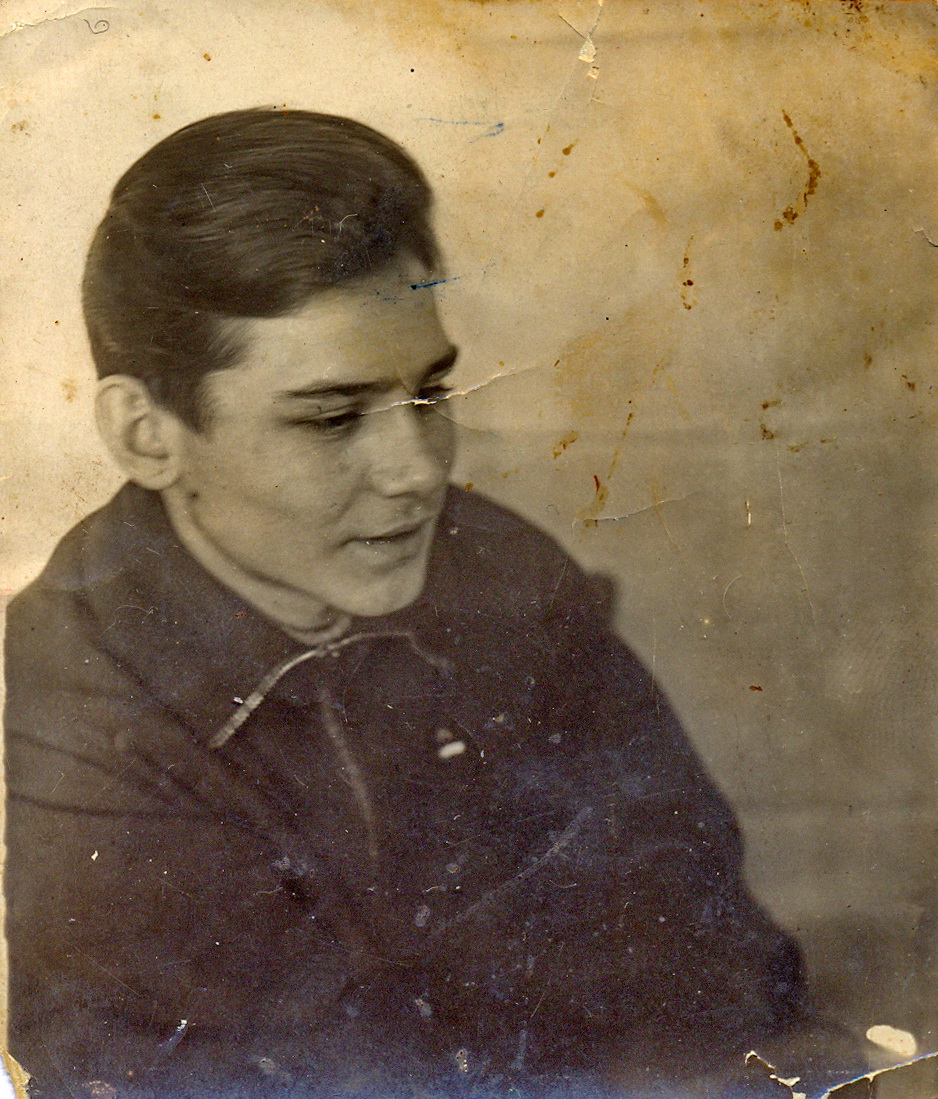 Aron Milman Killed in Mikolaev November 1942 |
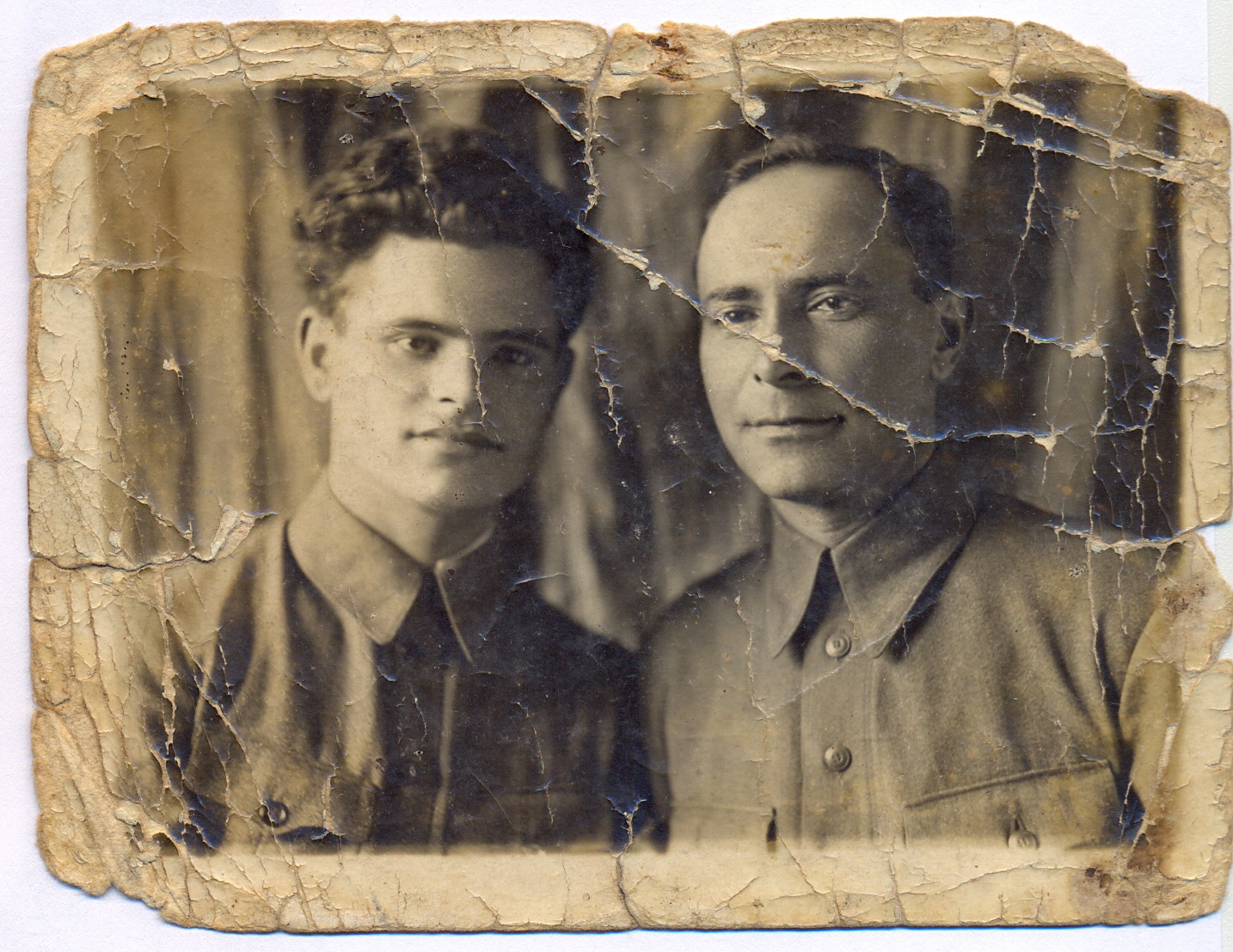 Isaac and Leib Milman |
Post WWII
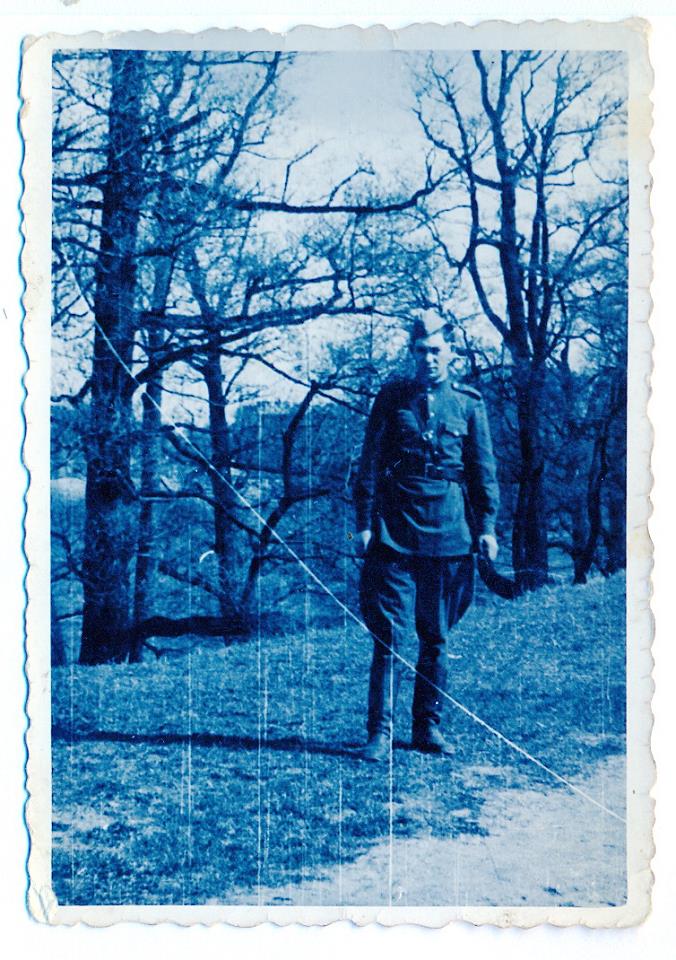 Syoma Marder 1945 Picture sent to Maroosya from Riga |
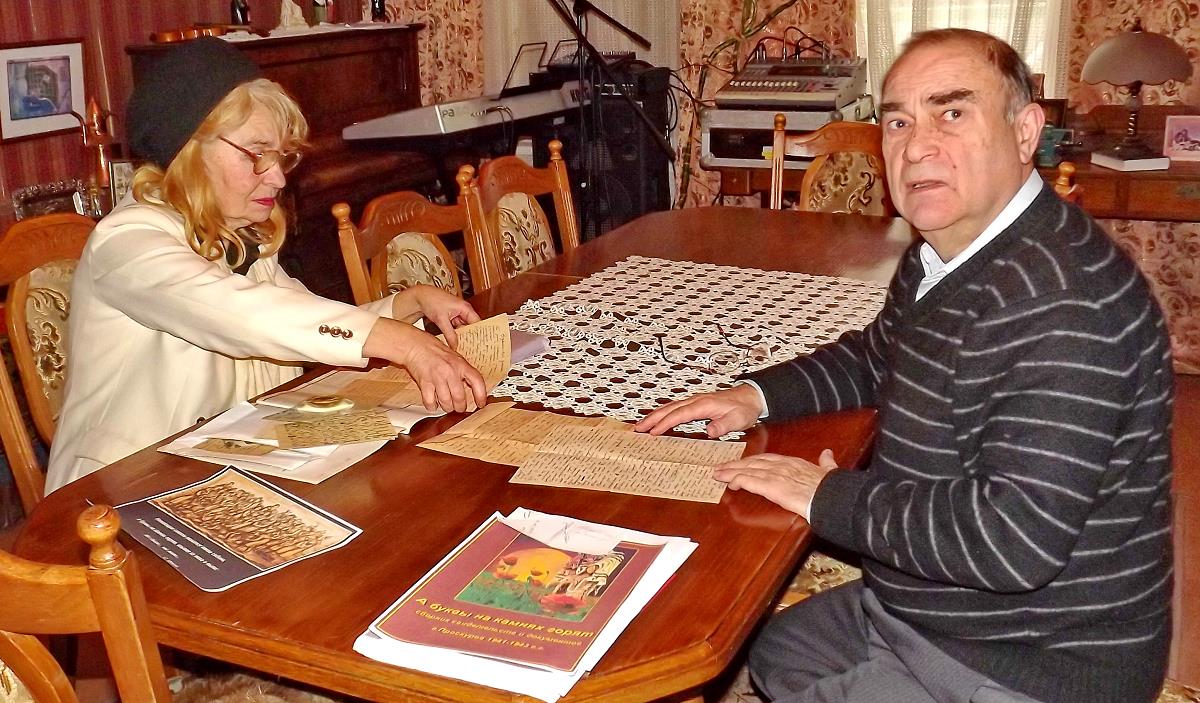 Galina Marder and Semyon Milman at Hesed-Besht |
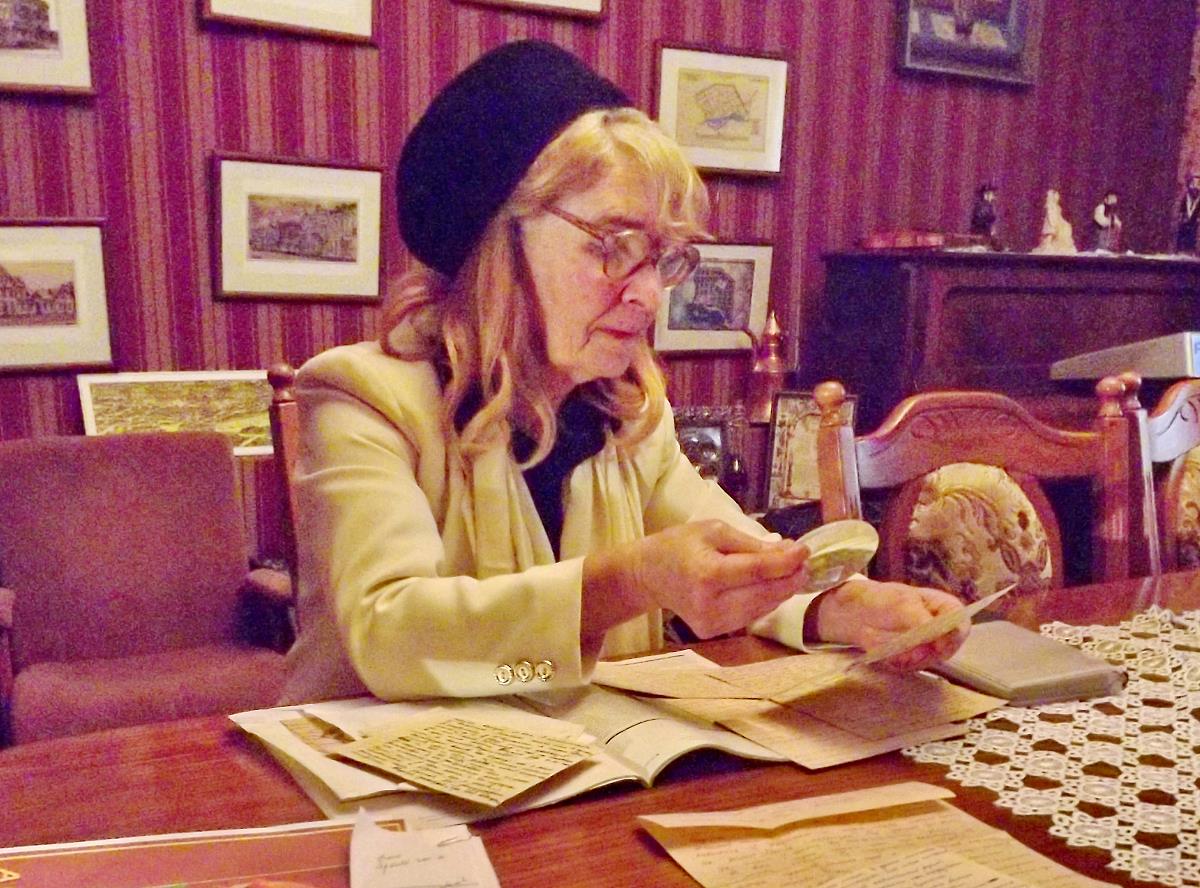 Galina Marder at Hesed-Besht |
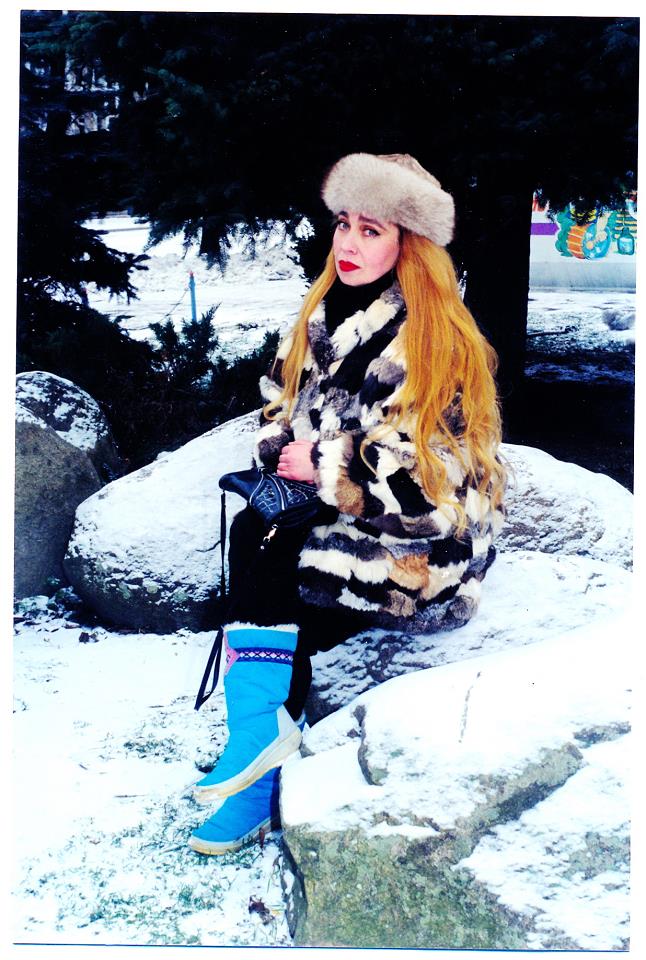 Galina Marder |
These paintings are by Galina Marder Lebedinskaya
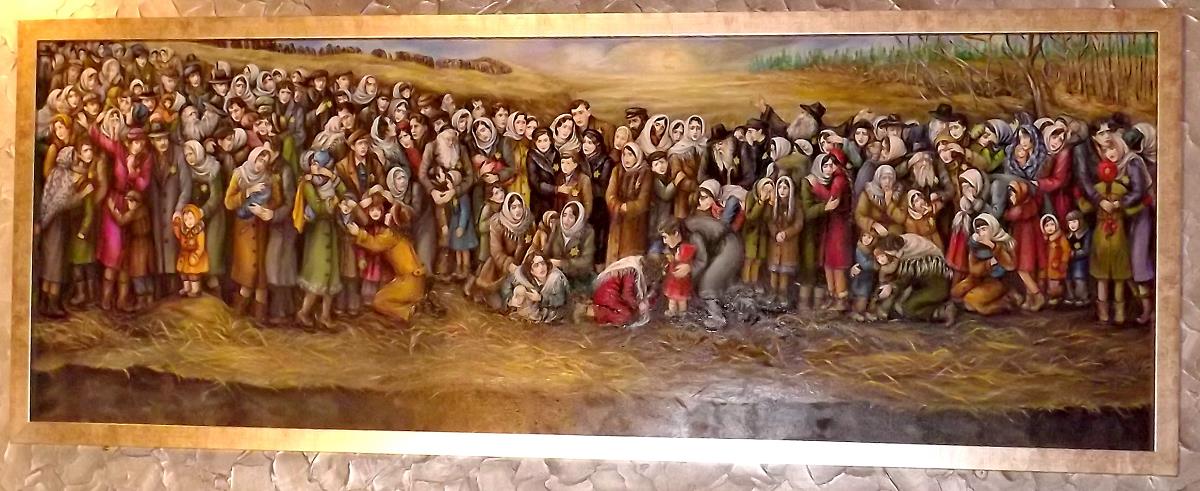 Mikolaev Jews at the Pit |
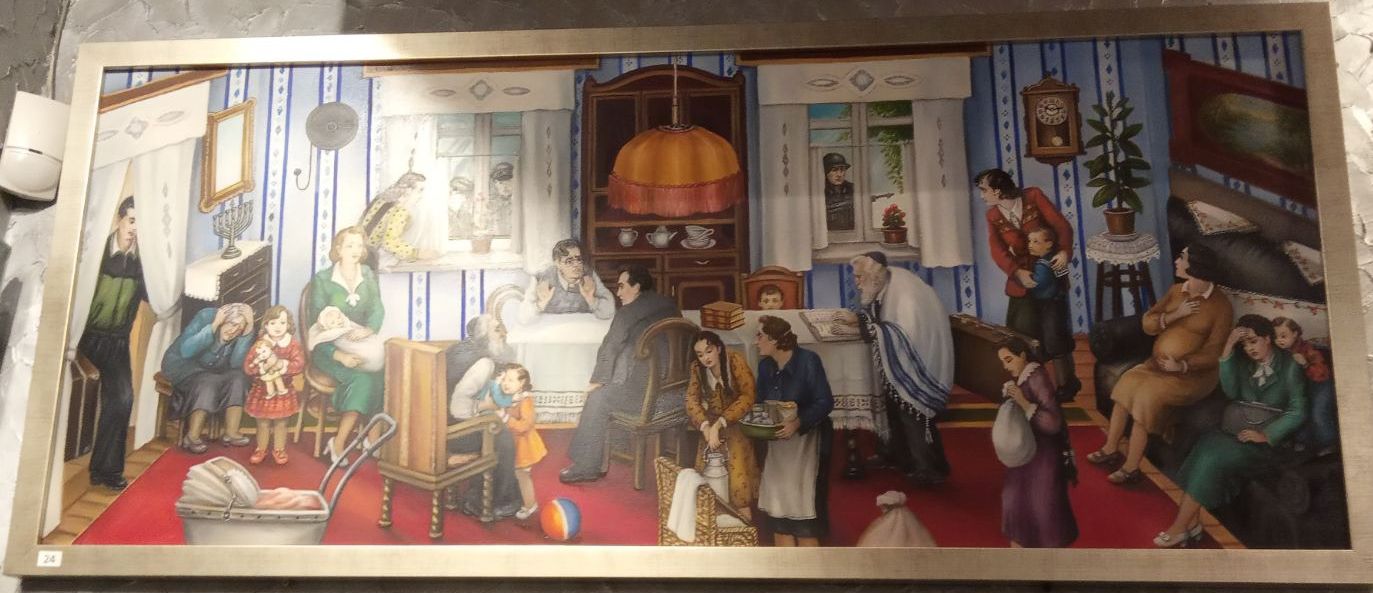 Jewish family before transition to the Ghetto |
